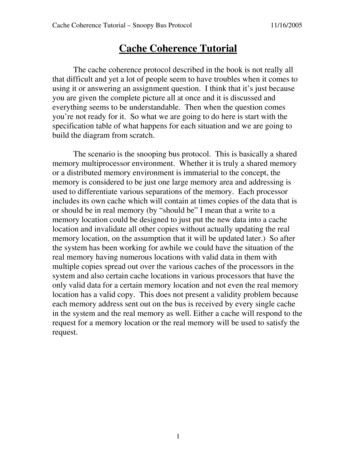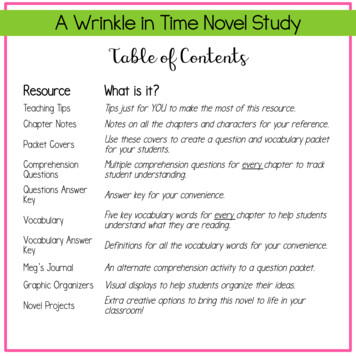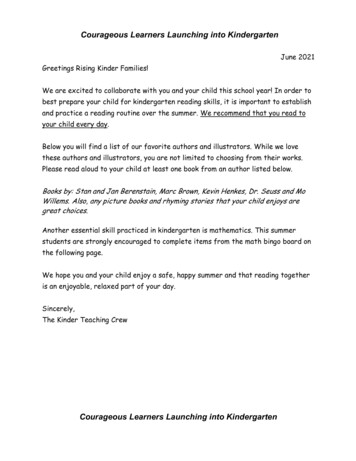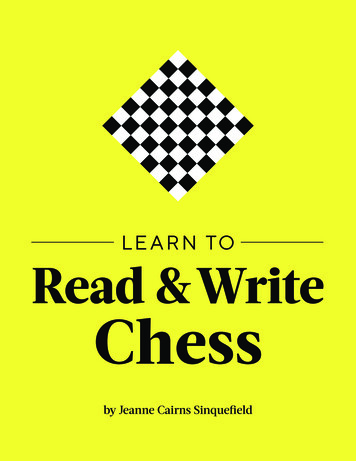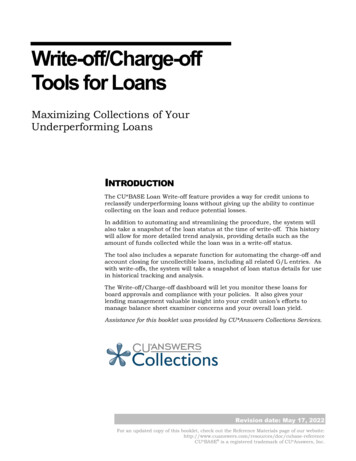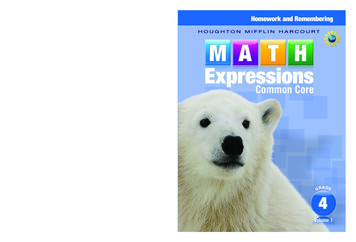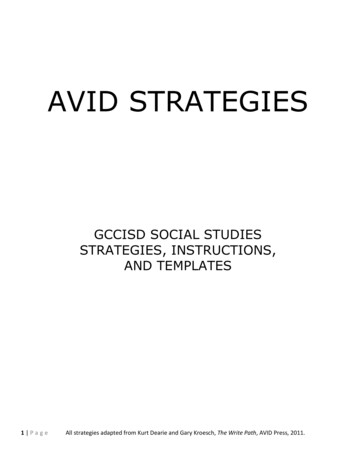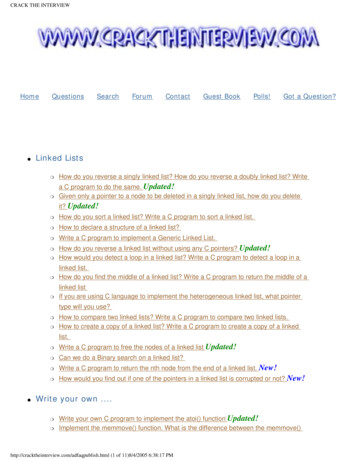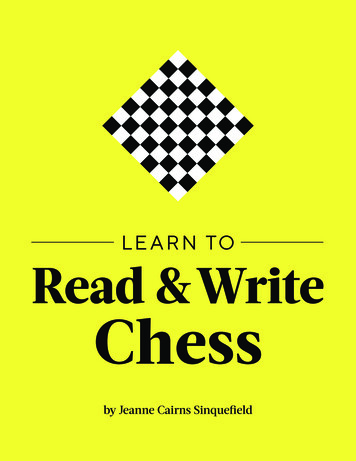
Transcription
L E A R N TORead & WriteChessby Jeanne Cairns Sinquefield 2018 Jeanne Cairns Sinquefield, All Rights Reserved.
You can play chess without knowing how to read or write chess.I learned how to play on the back porch with my grandfather. Neither henor I knew there were chess books, or that you needed to write downyour moves. We just played. Recently I decided I needed to become literate.I didn’t like any material available on learning to read and write chess.It was too complex, and was all reading based. Mine merges reading,talking, writing and physically moving pieces. And it breaks up necessaryknowledge into simple blocks a) piece names b) locations c)writtenmove types and d) combing a-c to merge playing with reading and writing.If I can become literate at my age (past 70) anyone can.Jeanne Cairns SinquefieldCofounder of the Saint Louis Chess ClubAcknowledgmentsThis project had help from many people including the staff at the Saint Louis ChessClub and the World Chess Hall of Fame, and chess players from grandmasters tobeginners. Special thanks to my grandson Logan who taught me about chess boardlocations, and my husband Rex who thinks everyone should play chess. 2018 Jeanne Cairns SinquefieldPublished & distributed by theVersion 10.World Chess Hall of FameAll rights reserved. No portion of this book may be reproduced,stored in a retrieval system, or transmitted in any form or by any4652 Maryland Avenue, Saint Louis, Missouri 63108worldchesshof.orgmeans, mechanical, electronic, photocopying, recording,Library of Congress Control Number: 2019904789or otherwise, without written permission from the publisher.ISBN: 978-0-9981536-1-2
Many chess players cannot read or write chess.It is a barrier to getting better at chess. But it is not hard to learn. The four steps tolearn are a) Chess Piece Letters b) Chess Board Locations c) Special Types of ChessMoves and d) Combining a-c to Write and Read Game Moves.TASKS FOR YOU TO DO!!!!Chess Pieces have Names and LettersFigure 1.King (K)Queen (Q)Rook (R)Bishop (B)Knight (N)(1)WRITE the Name and Letter of each piece. (No Pawn Letter)(2)PULL OUT Paper Chess Board (in center).(3)WRITE the letter (K,Q,B,N, or R) on each major chess piece.(4)CUT OUT individual chess pieces. May be glued to bottle caps, etc. 2018 Jeanne Cairns Sinquefield, All Rights Reserved.1
Chess Boards have Files, Ranks and LocationsChess Boards have Files (a,b,c,d,e,f,g,h) and Ranks (1,2,3,4,5,6,7,8). There are 8Files and 8 Ranks with 64 locations. Location is the File letter and Rank number,e.g. a1 or h7.Figure 2. Picture of board with File, Rank, and Location names.Black PiecesWhite Pieces(5)WRITE File letters and Rank numbers on paper chess board.File — a,b,c,d,e,f,g,h Rank — 1,2,3,4,5,6,7,8 Check with Figure 2.(6)WRITE every Location on paper chess board (all 64).e.g. a1, a2, to h8. Check with Figure 2.(7)POINT to every square and SAY its Location. e.g. f6(8)PLACE five pieces on board. SAY Letter and Location. e.g. Ra12 2018 Jeanne Cairns Sinquefield, All Rights Reserved.
(9)SET UP Positions on the Chessboard.Positions have Piece Letter (except Pawns) and Location, except pawnsonly have Location. For example King on e6 is Ke6. Pawn on g2 is g2.SET UP and SAY Positions on paperChess Board then WRITE positions.Figure 3a.Starting PositionWhite Ra1,Nb1,Bc1,Qd1,Ke1,Bf1,Ng1,Rh1WRITEWhite Pawns a2,b2,c2,d2,e2,f2,g2,h2WRITEBlack Ra8,Nb8,Bc8,Kd8,Qe8,Bf8,Ng8,Rh8WRITEBlack Pawns a7,b7,c7,d7,e7,f7,g7,h7XABCDEFGHYSW T8rnlqklnr(ZZZZ7pppppppp'6 ? ? ? ?&5? ? ? ?-%4 ? ? ? ? 3? ? ? ?-#ZZZZ2PPPPPPPP"T S1RNLQKLNR!xabcdefghyWRITEHELPFUL HINTSCheck with Figure 3a.Queen on own color.SET UP and SAY Positions on paperChess Board then WRITE positions.Rook on right, alwayson white square.White Ra1, Nc3, Qd2, Ke1,Bf1, Ng1, Rh1WRITEWhite Pawns a2,b2,c2,d4,e5,f2,g2,h2WRITEBlack Ra8, Nb8, Bc8, Qe7, Ke8, Nd7, Rh8WRITEBlack Pawns a7, b7, c7, d5, e6, f7, g7, h7WRITEFigure 3b.XABCDEFGHY8rnlSW?k? Tr(7pppnqppp'ZZWZ6 ? ?p? ?&5? ?pPZ?-%4 ? ZP ? ? 3? SN-? ?-#2PPPQZWZPPP"Z1RKLNR!T? SxabcdefghyCheck with Figure 3b. 2018 Jeanne Cairns Sinquefield, All Rights Reserved.3
Special Types of Chess MovesChess Moves (Notation) have a fixed order, see Figure 4. Chess moves use PieceLetters (Figure 1), Locations (Figure 2), Special Symbols and Notation (Figure 4).Figure 4. Order of Notation for Chess MovesSYMBOLNAME OF MOVEPiece LetterStart LocationxCaptureEnd LocationNOTESRequired for K, Q, R, B, or N. (not pawn)If same pieces can go to End Location, e.g. Ngf2, R1a3, cxd4e.g. Nxa5, Knight captures on location a5, dxe7 (Pawn)Required, e.g. d5 (pawn) or Rf5, End Location is Rook on f5epEn passant Pawn Promotion Checke.g. Bh3 , Bishop moves to h3, puts King in Check# or Checkmatee.g. Qe7#, Queen moves to e7, King in CheckmateSPECIAL MOVESe.g. gxf6ep, Pawn on rank ge.g. e8 Q, Pawn moves to e8, swaps for QueenSee Figure 9.0-0Castle (kingside)White: Kg1, Rh1f1 Black: Kg8, Rh8f80-0-0Castle (queenside)White: Kc1, Ra1d1 Black: Kc8, Ra8d8(10)START and PLAY MOVES on paper Chessboard.SAY examples. Simple Rule: Order of Notation same as spoken words.Possible Start Locations are given in parentheses ().COMMON EXAMPLESOF CHESS MOVES:4a4Pawn moves to location a4 (e.g. starts a2)g6Pawn moves to g6 (e.g. starts g5)Ngf2Knight moves from g4 to f2or N4f2 (Add g file or 4 rank if Start Location is needed)gxf5e8 QPawn on g file captures on f5, see Figure 5.(Use file name for Pawn captures)Bd2Bishop moves to location d2 (e.g. starts c1)Ne3Knight moves to e3 (e.g. starts g2)Nxf2Knight captures on location f2 (e.g. starts g4)Bh3 Bishop moves to h3, checkdxe7Pawn on file d captures on e7 (e.g. starts d6)Qc2#Queen moves to c2, checkmate, see Figure 8b.White pawn promotion on e8, swaps forQueen (e.g. starts e7), see Figure 7. 2018 Jeanne Cairns Sinquefield, All Rights Reserved.
PULL OUT PAPER CHESSBOARD
f 2018 Jeanne Cairns Sinquefi eld, All Rights Reserved.
2018 Jeanne Cairns Sinquefi eld, All Rights Reserved.g
PULL OUT PAPER CHESSBOARD
(11)SET UP, SAY, and MOVE on paper Chess Board.Play each example of chess move(s) on chess board.(12)WRITE chess notation on line below Figures 5-9.Figures 5-9. Examples of special types of moves on a board.5. Capture x Pawn x6. En passant ep7. Pawn promotion Nxa5White to b4. Black captures b4,Pawn moves to f8, swaps for Queen:gxf5 (note 2 pawns can move)moves to b3: cxb3epf8 QXABCDEFGHY8 S? W? ? T?(7Z? Z? Z? Z?p'6 ?N? ?p?&5pZ? ?p?-%4 ? ?P?P? 3? ? ? ?P#2 Z? Z? ? Z?"1T? ? ? S? !xabcdefghyXABCDEFGHY8 S? W? ? T?(7Z? Z? Z? Z? '6 ? ? ? ?&5? ? ? ?-%4 ?p? ? ? 3? ? ? ?-#2 ZP Z? ? Z?"1T? ? ? S? !xabcdefghyXABCDEFGHY8 S? W? ? T?(7Z? Z? Z?PZ? '6 k ? ? ?&5? ? ? ?-%4 ? ? ? ? 3? ? ? ?-#2 Z? Z? ? Z?"1T? ? ? S? !xabcdefghyWRITEWRITEQWRITE8a. Check 8b. Checkmate #9. CastlingBc5 Qc2#Queenside: 0-0-0 Kingside: 0-0XABCDEFGHYXABCDEFGHY8 S? Tr ? T?(7Z? Z? Z? Z? '6 ? ? ? ?&5Z? ? ? ? %4 ? ? ? ? 3PZ?q? ?-#2KZ? Z? ? Z?"1RT? ? ? !xabcdefghyXABCDEFGHY8rS? T?kl Tr(7plqpZWZ?ppp'Z6 Zpn?p? ?&5Z? Zpn? ?-%4 ? ZP ? ? 3Z? ZPLPNN-#ZS2PPQZZ? ZPPP"Z1RT L K ?R!xabcdefghy8 S? W?rk T?(7Z? Z? Z? Z? '6 ? ? ? ?&5Z? ? ? ? %4 ? L ? ? 3? ? ? ? #2 Z? Z? ? Z?"1T? ? ? K !xabcdefghyWRITEWRITE 2018 Jeanne Cairns Sinquefield, All Rights Reserved.WRITE5
Writing and Reading Chess MovesTime to play a game using written notation (moves).(13) PLAY the following game on your paper chess board.USE Starting Position, Figure 3a. Check ending position with Figure 11.Figure 11.Figure 10.Scholar’s DEFGHY8r¡lqkMWS¡nr(T7ppppZZ¡Qpp'Z6n? ? ? ?&5? l pZ? %4 ?L?P? ? 3? ? ? ? #2PPPPPPP"ZZZZ1RNLT K NR!Sxabcdefghy(14)PLAY a chess game with partner.Write down the moves on score sheet. See next page for exampleof score sheet. After 4 moves check if partner’s score sheet is sameas yours. Finish game.(15)REPLAY your game using your score sheet.Can you replay it?(16)PLAY six more games using score sheets.Play as white and black. Check score every 4 moves. Can you replay it?(17)PLAY moves using book format. USE Starting Position.Book format is number, white move, black move.1. e4 e52. Nf3 Nc63. Bb5 a64. Ba4 b55. Bb3 Nf6(18)TEACH someone else to Read and Write Chess.Congrats. You can read and write chess. To get better play andnotate more games. Also play the games from books.6 2018 Jeanne Cairns Sinquefield, All Rights Reserved.
W60RESULT:30295929BLACKSECTIONWHITE 219184748171815124142111293839865439BLACK WON8344WHITE WHITESECTIONTIME CONTROLBOARDROUNDWHITEDATEBLACK WONBLACKTIME 84746454443424140393837363534333231BLACKDATE(314) 361-CHESS (2437)(314) 361-CHESS LUB.ORG
W60RESULT:30295929BLACKSECTIONWHITE 219184748171815124142111293839865439BLACK WON8344WHITE WHITESECTIONTIME CONTROLBOARDROUNDWHITEDATEBLACK WONBLACKTIME 84746454443424140393837363534333231BLACKDATE(314) 361-CHESS (2437)(314) 361-CHESS LUB.ORG
Games for Chess CoachesJeanne’s Games for Learning Chess Notation1. Piece Name — Letters K,Q,B,N,R and P.a. Show Piece, kids yell out Letterb. Say letter name of piece, kids pick up correct piece.c. Show Piece, kids write down Letter. Winner(s) with most correct.2. Location Names — a,b,c,d,e,f,g,h; 1-8a. Show location on board, kids yell out location, eg. d3b. Show location on board, kids write down location, eg. a4,Winner(s) with most correct.c. Say location name, kids place piece on boardd. Say location name, kids say if white or black.e. Show list of written locations for black and white pieces, kidsplace all pieces on board. Use to set up a position. Winner(s) isfastest with correct locations.3. Move Name — capture(x), castle(0-0,0-0-0), en passant, check( ),checkmate( )a. Show list of names of moves, kids write down notation.Winner(s) is fastest and correct.b. Play one move, kids yell out move notation.c. Play several moves, kids write down move notation. Winner(s)has all correct.4. Game moves — piece, location, move, and location notation.a. Play one move, individual kid yells out (piece, location, move,location) notation.b. Play several moves or game, kids write out complete notation,winner all right.c. Show list of game moves, kids play moves on board. Winner hascorrect final position in least time.Teacher preparation lists are needed for 1c,2b,2e,3a,3c,4b,4c tocheck winners results. Young children may be slow in writing notation,and reading notation quickly. So may limit to 1a,1b,2a,2c,2d,3b,4a. 2018 Jeanne Cairns Sinquefield, All Rights Reserved.9
“This book will help any chess player learn to read andwrite chess. This is also a great resource for parents andcoaches. I wish I had learned at a younger age.”—Tony Rich, Executive Director, Saint Louis Chess Club“Chess has a reputation for being hard and difficult tolearn. Not true! When you learn to read and write chess,it becomes so much easier. I learned to read at age 4.”—Grandmaster Yasser Seirawan, Four-time U.S. Chess Champion“This booklet can be used in a classroom to help kids:a) Learn to read, write, and follow directions.b) Increase spatial awareness to recognize patterns.c) Develop memorization skills and strategies forproblem solving.”—Karen Wulff, retired second grade teacherSaint Louis Chess Campussaintlouischessclub.org worldchesshof.org 2018 Jeanne Cairns Sinquefield, All Rights Reserved.
Many chess players cannot read or write chess. It is a barrier to getting better at chess. But it is not hard to learn. The four steps to learn are a) Chess Piece Letters b) Chess Board Locations c) Special Types of Chess Moves and d) Combining a-c to Write and Read Game Moves. TASKS FOR YOU TO DO!!!! Chess Pieces have Names and Letters Figure 1.
